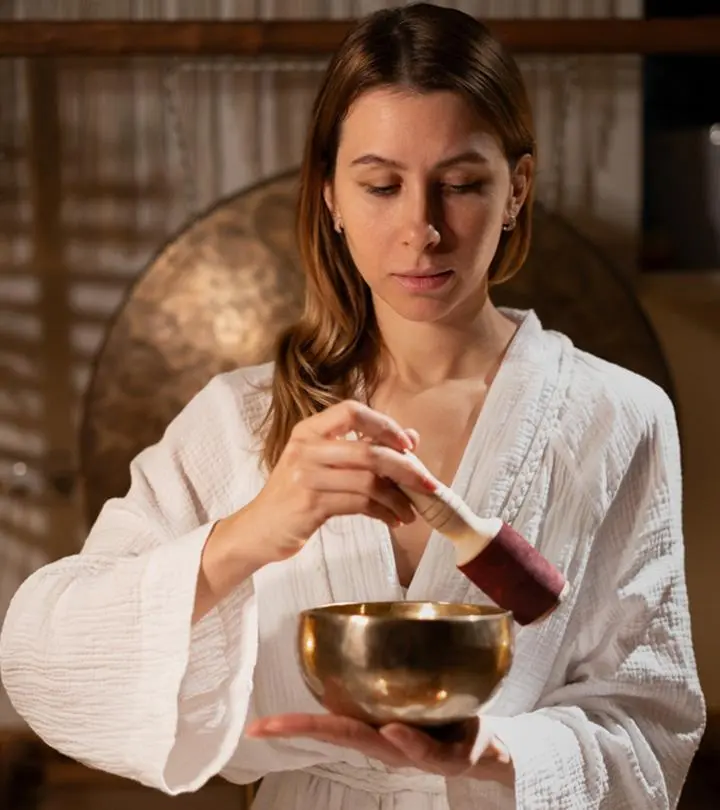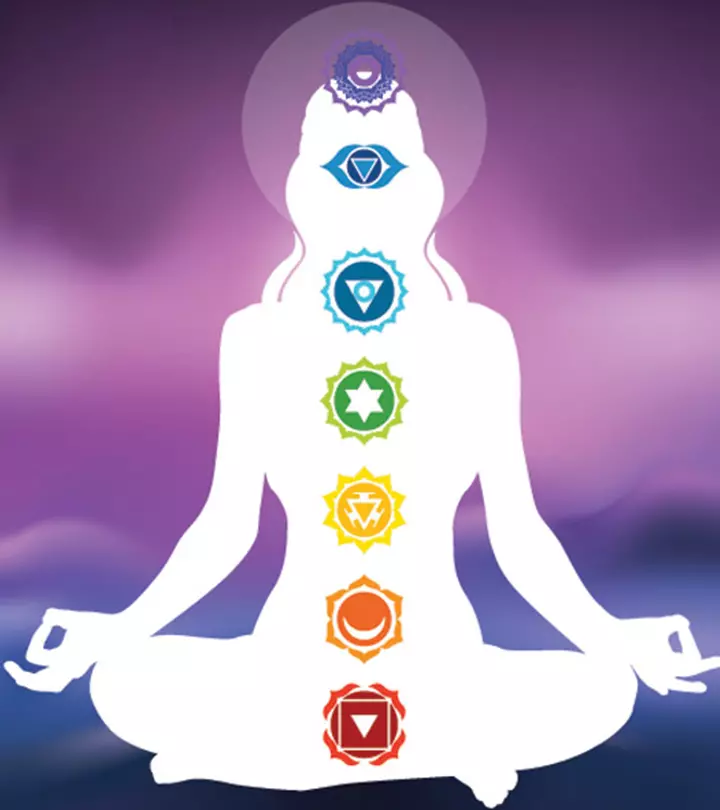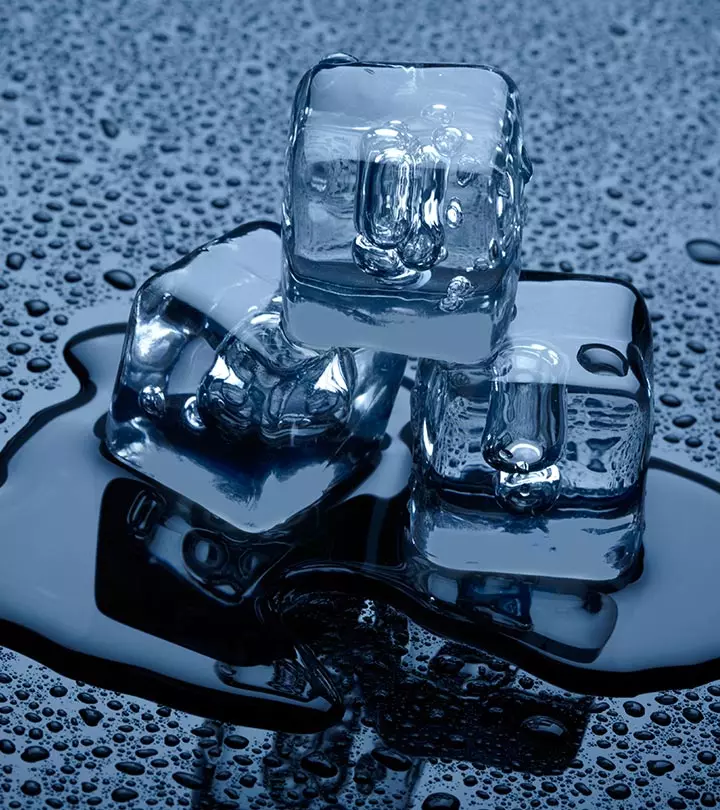What is a Sound Bath? How Does It Help Health?
Immerse yourself in waves of soothing sounds in varying frequencies and relax your body and mind.

Image: Shutterstock
While life can be stressful, we all can use some self-care to feel better. A sound bath is one such relaxing experience. Although it’s called a bath, it has nothing to do with soaking in a tub. It instead is about immersing yourself in deep, resonant sounds that heal from within. Sound therapy has been used for therapeutic benefits for thousands of years – from Egyptians who treated sick patients with it to the present-day use of Tibetan singing bowls. Read on to learn more about this technique and how it can benefit you.
 Did You Know?
Did You Know?In This Article
What Is Sound Bath Therapy?

A sound bath is a meditative experience in which participants are immersed in a sound frequency that helps them relax and heals their bodies. Musical instruments, such as chimes, Tibetan singing bowls, tuning forks, and gongs are used to produce soothing waves at different frequencies. The sound produced is not a rhythm or a melody but a voice with notable resonance and overtone. While sound baths are generally conducted and experienced in a group setting, they also can be done at home.
Key Takeaways
- A sound bath is a meditative practice that helps relax the mind and body.
- It helps reduce stress and anxiety and boosts positive energy and mood.
- While it is generally practiced in group sessions, you can also do it at home with the help of recordings.
How Do Sound Baths Work?

A sound bath is also referred to as a yoga sound bath as it involves lying down in a Shavasan position on a yoga mat and mindfully listening to the sounds produced by musical instruments. You can also sit in a comfortable position if you don’t want to lie down. A trained sound healer facilitates the experience by creating soothing overlapping sonic vibrations. Such a guided experience usually lasts for 45-60 minutes.
Sound therapists and meditation teachers also believe that sound baths can bring balance, relaxation, and a sense of calm to the body. These baths can also be compared to other healing practices as the vibrations they produce lead to a deeper state of relaxation and shut off the body’s fight or flight reflex. Sound baths offer various other benefits too.
Health Benefits Of Sound Baths

Sound baths work off the principle that there are potential benefits of listening to music during meditation. It makes the process more immersive and wholesome. Scroll below to learn more about the possible benefits of this meditative experience.
1. Offer Relaxation
Sound baths effectively manage chronic stress and anxiety and provide deep relaxation. According to sound healing practitioners, the frequency used in sound baths influences meditation brain waves, shifting them from a normal state of beta waves to alpha and theta waves(which are deeper states of consciousness achieved during meditation), which eventually calm the mind.
Rigel Gemini, a YouTuber, shared his experience of doing a sound bath in his vlog. He said,“ I definitely feel relaxed, clear-headed, and calm. The sound kind of takes over, and even though the bowls can be kind of far away from you, the vibration is so loud that you actually feel it in your head. It’s a pretty cool feeling (i).”
2. Boost Mental Health
Sound baths are proven to be of great help in boosting mental health. In a study conducted on a few patients, there was a significant reduction in feelings of anxiety, fatigue, tension, anger, and depression after a sound bath (1). Tibetan singing bowls used in sound baths also effectively reduced distress in patients with chronic spinal pain and metastatici The ability of cancer cells to spread from their primary site of origin to other organs of the body. cancer (2).
3. Enhance Physiological Health Parameters
Sound healers state that vibrations heard in the baths harmonize the body’s cells and promote healing. The singing bowl’s vibration in the sound bath reduces blood pressure and heart rate, which activates the parasympathetic nervous systemi A division of the nervous system, also called the ‘rest and digest system’, which relaxes the body after periods of stress or danger. to counter the flight or fight response of the body (1). Sound healing also improves respiratory rate and peripheral capillary oxygen saturation, which aid physical healing (2).
4. Promote Spiritual Well-Being
Sound healing practitioners believe that a sound bath helps unblock chakras.
This helps process emotions better and increase spiritual well-being. Chakras, as per Hinduism, are the centers of spiritual power or energy. Some participants who practiced sound baths also experienced positive energy and improved mood (3).
While these benefits look promising, you also need to consider the possible side effects of a sound bath.
Side Effects Of Sound Bath
There is no evidence to suggest sound baths have any side effects. However, some people have reported exhaustion after a session. The strong vibrations can also trigger headaches in those sensitive to noise. Sound baths also help process different emotions, possibly unearthing past emotional trauma in the process and making one feel nauseousi An uncomfortable feeling in the stomach that causes an urge to vomit but does not always lead to vomiting. or dizzy. Hence, it is better to consult with a therapist to resolve such feelings.
Note: It is advisable to consult with a healthcare professional before participating in a sound bath session if you have a history of sound sensitivity, anxiety disorders, or any underlying medical conditions. Choose a peaceful and quiet environment where you will not be disturbed to have a positive experience. Further, having a clear exit strategy in case you feel overwhelmed or uncomfortable can provide a sense of security and control.
How To Experience A Sound Bath
You can experience a sound bath in many ways. It can be experienced in a group setting, on a one-to-one basis, or even alone at home.
a. Sound Bath At Home
Sound baths are very accessible. You can try one at home if group sound bath sessions are not offered in your area or you simply feel uncomfortable in a group setting. You can easily find recordings on some websites or via subscriptions and use them to practice sound baths at home. Playing these sounds on a good-quality speaker or headphone can help you meditate.
Sit in a comfortable position or lay down on a yoga mat in a Shavasan position, dim the lights, set the goal or intention of the session, and play the recording while you focus on the breathing and immerse in the sounds.
You can also use instruments such as singing bowls or tuning forks. Place them on the floor, sit comfortably, and play them. Focus on your breathing throughout the session.
 Quick Tip
Quick Tipb. Sound Bath Tips

- Sound baths are ideal for those who have a hard time practicing traditional meditation or yoga or tend to overthink while meditating traditionally.
- Always focus on breathing while immersing yourself in the waves of the soothing sounds.
- Keep your eyes closed or wear an eye mask to encourage deeper relaxation and avoid getting distracted.
- If you are doing a sound bath at home, wear headphones to hear the sounds clearly and with total concentration.
- Think about a goal, intention, or prayer for your meditation practice.
c. Instruments For Sound Bath

Instruments required for a sound bath meditation include:
- Tibetan singing bowls
- Crystal bowls
- Chimes
- Tuning Forks
- Gongs
- Drums
- Digital sounds
If you do not have any instruments for performing a sound bath at home, you can also use guided recordings available online.
While musical instruments are employed in sound bath and musical therapy, both are two different approaches. Know more in the next section.
Sound Bath Vs. Music Therapy: Key Differences
There is a difference between sound healing and music therapy.
Music therapy is a clinical intervention that involves music, songwriting, and the selection of the right song to improve the emotional state of an individual. Qualified music therapists carry this out to help people express their emotions, process their feelings, and improve their mood.
A sound bath is more of a spiritual practice that uses yogic or guided meditation (and does not involve singing songs). It helps heal the body and reduce stress and anxiety through specific frequencies and harmonies. Resonant sounds are produced by musical instruments at different frequencies that help balance emotions.
Sound bath sessions are generally conducted by a person who has had training in music to conduct sound bath sessions or has a background in yoga or meditation.
If you want to enjoy one such session, it is important to have a budget in mind. Get an idea about the same from the next section.
How Much Does A Sound Bath Cost?
The cost of a sound bath session depends on its location, duration, the expertise of the practitioner, and the instruments used. A one-hour group sound bath session in a yoga studio or wellness center may cost anywhere between $20 and $50 per person. Private or personalized sessions that offer a more intimate experience with guided meditation may cost between $75 to $150 or more per hour.
Some practitioners also offer sound bath memberships or package deals that reduce the cost per session for regular attendees. Additionally, online platforms may offer virtual sound bath experiences at a lower cost or even for free. You may research local practitioners or online platforms to find a sound bath experience that fits your budget and preferences.
Infographic: Important Benefits Of A Sound Bath
A sound bath is a unique relaxation technique that helps reduce stress and anxiety by helping one immerse in sound. Different musical instruments are employed to produce healing vibrations that relax the body. Sound baths have many benefits, and we have discussed the most important of those in the infographic below!

Illustration: StyleCraze Design Team
Conclusion
Sound bath is a healing practice that immerses you in soothing waves of sounds and helps you unwind. It reduces stress and anxiety, improves mindfulness, increases spiritual well-being, lowers blood pressure, and improves mood by boosting positive energy. This ultimately allows you to access a deeper state of consciousness and feel relaxed. It’s a unique experience that can easily complement any healing or wellness program. Follow the tips mentioned in this article and start your own sound bath session today.
Frequently Asked Questions
How often should you do a sound bath?
It depends on what works best for your body. While some might need it daily, others might need it once or twice a week.
Why do I feel tired after a sound bath?
Some people might feel tired after a sound bath as a lot of energy is utilized in this holistic activity. It also may make one sleepy.
Do sound baths help you sleep?
Yes, sound baths make your brainwaves go into a state of alpha relaxation and makes you fall asleep.
Illustration: What Is A Sound Bath? How Does It Help Health?

Image: Stable Diffusion/StyleCraze Design Team
Relax and unwind with this perfect bedtime sound bath. Watch the following video and let the soothing sounds take you away and drift off into a peaceful sleep.
Personal Experience: Source
StyleCraze's articles are interwoven with authentic personal narratives that provide depth and resonance to our content. Below are the sources of the personal accounts referenced in this article.
i. Unexpected experiences: sound healing / sound bath reviewhttps://www.youtube.com/watch?v=XZKv5TYeBVI
References
Articles on StyleCraze are backed by verified information from peer-reviewed and academic research papers, reputed organizations, research institutions, and medical associations to ensure accuracy and relevance. Read our editorial policy to learn more.
- Effects Of Singing Bowl Sound Meditation On Mood Tension And Well-Being: An Observational Study
https://www.ncbi.nlm.nih.gov/pmc/articles/PMC5871151/ - The Human Health Effects Of Singing Bowls: A Systematic Review
https://pubmed.ncbi.nlm.nih.gov/32507429/ - Impact of Himalayan Singing Bowls Meditation Session On Mood and Heart Rate Variability
https://openaccesspub.org/ijpr/article/1282#
Read full bio of Dr. Saba
Read full bio of Sindhu Koganti
Read full bio of Ravi Teja Tadimalla
Read full bio of Payal Karnik


























Community Experiences
Join the conversation and become a part of our empowering community! Share your stories, experiences, and insights to connect with other beauty, lifestyle, and health enthusiasts.